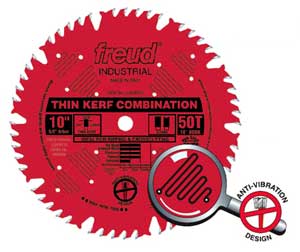
I suspect many home woodworkers have had the same debate I’m going through: Which 10″ table saw carbide “combination” blade will perform best for me? What number of teeth, type of teeth, and hook will give the most usefulness from a combination blade? ATBR? Newer ATB with sides of teeth ground as smoothers (like Freud’s)? Thin kerf? Like most, I commonly saw hard and softwoods , rip the same, saw thin ply (like drawer bottoms), want glue-line edges from cuts, and occasionally overwork my saw by “resawing” up to 3+” drawer sides. Considering my uses and misuses, how do I select the combination blade that will work best on my saw? – Don
Cliff Paddock: I agree that the cutting challenges you describe are probably very common among home woodworking enthusiasts, as well as a lot of full-time pros. For the range of applications you mention, I would recommend a 10″ x 50T combination blade, preferably with ATB/flat geometry (sometimes called ATB / Raker, or ATBR). The typical “combination” blade features a very deep gullet at intervals of every fifth tooth, which helps clean out the heavy buildup of fiber and dust you encounter during rip cuts. The flat-top raker tooth helps clean out and guide during the cut, while the ATB teeth provide a cleaner cut in crosscuts by “scoring” the sides of the kerf. Most home woodworkers will prefer the thin kerf combination blade, like Freud’s LU83R010, if their saws have less than 3hp motors.
Of course, there are a number of blades on the market designed to cut certain materials — HiATB blades for cuts in thin plywood, for example, or blades with flat-top teeth for ripping – but many woodworkers prefer to have one “do it all” blade to reduce their tool investment and save time changing blades. Just remember that, in order to give you the best all-around performance, combination blades represent a compromise among the key features of these application-specific tools. My advice would be to take note of the applications in which you do the most cutting, then consider adding a specific blade for these key tasks, as your budget permits, to give you premium performance in the jobs you tackle most often. (Cliff Paddock is cutting tools product manager for Freud America.)





